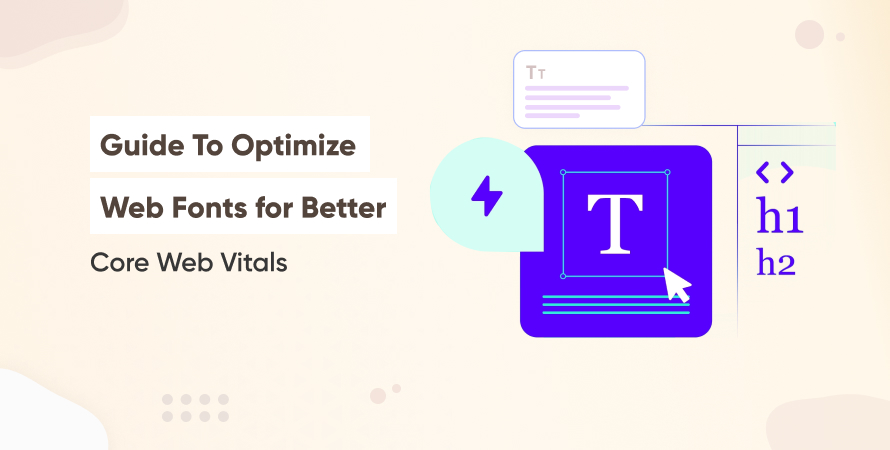Guide To Optimize Web Fonts for Better Core Web Vitals



Introduction
In the competitive digital landscape, user experience has evolved into a ranking factor that businesses can no longer ignore. Google’s Core Web Vitals have become central to how websites are evaluated for speed, interactivity, and visual stability. One often underestimated factor that impacts these metrics is web fonts.
Custom fonts play a vital role in branding and design, yet they can also degrade website performance if not optimized correctly. This blog explores how to optimize web fonts to enhance Core Web Vitals, offering practical advice for developers, designers, and digital marketing agencies looking to improve page load times, usability, and search rankings.
Whether you’re managing a content-heavy blog, e-commerce site, or landing page, optimizing your fonts can be a game-changer for both user experience and SEO.
Understanding Web Fonts & Their Role in Performance
Web fonts are custom font files loaded from external or internal servers and rendered on users’ browsers. Unlike system fonts, which are pre-installed on devices, web fonts need to be fetched via HTTP requests. While they offer flexibility in design, they introduce additional weight and complexity to page loads.
How Fonts Affect Core Web Vitals
Web page fonts directly influence:
- Largest Contentful Paint (LCP): Delays in loading text font can defer rendering of large text elements.
- First Input Delay (FID): Font-related render-blocking resources can interfere with interactivity.
- Cumulative Layout Shift (CLS): Invisible text (FOIT – Flash of Invisible Text) or shifting text due to late-loaded fonts causes visual instability.
When not optimized, fonts can easily account for 100–300KB of data and add critical milliseconds to your page load.
The Hidden Cost of Beautiful Typography
Typography is a core element of design. Digital marketing agencies often emphasize unique font styles to differentiate brands. However, this focus on aesthetics can inadvertently sacrifice performance.
Custom font files are frequently large, and many websites load multiple font weights and styles—most of which aren’t even used. This leads to longer page loads, increased bounce rates, and lower search rankings.
It’s not uncommon to see brands loading multiple font families, each with numerous weights, just to accommodate a few headlines or CTA buttons. Without proper font display optimization and loading strategies, this becomes a liability rather than an asset.
Best Practices to Optimize Web Fonts for Core Web Vitals
1. Use Modern Font Formats (WOFF2)
WOFF2 (Web Open Font Format 2) is a compressed format supported by all modern browsers. Compared to traditional formats like TTF or OTF, WOFF2 significantly reduces font file size and loads faster. Always serve WOFF2 files where possible, falling back to WOFF or TTF only for older browser compatibility.
2. Subset Fonts to Reduce Font Load
Most font files contain hundreds of characters, including scripts and symbols that your site may never use. Subsetting trims this excess by including only the characters necessary for your content.
For example, if your website uses only Latin characters, there is no need to load full sets with Cyrillic or Chinese characters. Font subsetting can reduce file size by up to 90%, improving LCP and time to first paint.
3. Preload Key Fonts for Faster Rendering
Preloading tells the browser to fetch important resources (like your main font) early in the loading process. Use:
<link rel=”preload” href=”/fonts/yourfont.woff2″ as=”font” type=”font/woff2″ crossorigin=”anonymous”>
This is especially helpful for large headings or hero sections using custom fonts. It ensures critical content is painted sooner, improving perceived speed.
4. Optimize Font Display with font-display: swap
The font-display CSS property controls how a font is rendered while it’s still loading. Using font-display: swap allows fallback fonts to be displayed immediately, which then switch to the custom font once it loads.
@font-face {
font-family: ‘MyFont’;
src: url(‘myfont.woff2’) format(‘woff2’);
font-display: swap;
}
This eliminates blank text during load (FOIT), drastically improving visual stability and CLS scores. Other options like auto, fallback, or optional can also be used but may have more trade-offs in terms of flash or shift.
5. Use System Fonts When Possible
System fonts are instantly available and don’t require loading, making them ideal for body text and functional UI elements. Common choices include Arial, Helvetica, and Georgia. Pair system fonts with branded display fonts to strike a balance between aesthetics and speed.
Advanced Techniques for Developers
Self-host Fonts for Full Control
By self-hosting fonts instead of relying on third-party services like Google Fonts, you gain complete control over caching, font compression, and HTTP headers. This can reduce DNS lookups and avoid potential privacy issues or external dependencies.
Critical Font Path Optimization
Load only the fonts necessary for content above the fold during the initial page render. Fonts used later on the page can be lazy-loaded using JavaScript or media queries. This reduces the time-to-interactive metric and improves user experience.
Inline Critical CSS for Fonts
For performance-critical elements, inlining minimal CSS file for font styles helps the browser render content faster. Be careful to avoid bloating your HTML, but when used strategically, this can make a notable difference in speed.
Avoid Render-Blocking Scripts
Fonts for websites should never be loaded using synchronous JavaScript, which can delay rendering. Always use async or defer attributes where applicable.
Replace Text Images with Fonts
Using fonts instead of images for headlines and CTAs improves accessibility, scalability across screen sizes, and SEO. It also reduces the need to load large image files, especially on mobile.
Display Optimization for Different Devices
Responsive font delivery is essential for optimizing font rendering across different screen sizes and devices. By serving lighter font files to mobile users through media queries or device detection, you can reduce load times and improve performance, especially on slower networks or older smartphones. Prioritizing readability with appropriate font sizes and line spacing ensures a better user experience without sacrificing speed.
Variable fonts offer an efficient solution by combining multiple font weights and styles into a single file. This reduces the number of HTTP requests and overall file size, making them ideal for responsive design. Their adaptability allows for smooth scaling and transitions between styles, enabling developers to maintain consistent branding while optimizing for performance.
Choosing the Fastest Fonts for Your Brand
Font speed doesn’t mean compromising identity. When choosing web fonts:
- Select minimal weights (400 and 700 are often sufficient)
- Use variable fonts when possible
- Combine branded headings with system body fonts
Popular fast-loading fonts include:
- Inter
- Roboto
- Lato
- System UI (San Francisco, Segoe UI, etc.)
These fonts are not only lightweight but also widely supported and legible.
Tools & Resources
Google Fonts Performance API
Allows developers to analyze the impact of fonts served via Google Fonts on performant websites. It provides detailed insights into loading text for images and font usage efficiency, helping to identify unnecessary weights or styles.
Font Subsetter by Fontsquirrel
A powerful tool that lets you customize and compress font files by removing unused characters, significantly reducing file size and improving load speed without affecting visual quality.
WebPageTest.org for detailed load analysis
Offers in-depth diagnostics of font loading behavior, including timing breakdowns and render-blocking issues. It’s useful for spotting performance bottlenecks caused by fonts.
Chrome DevTools: Network tab > Fonts
Enables real-time monitoring of how and when fonts load during a page visit. It helps in identifying large or slow-loading font files and testing changes immediately.
Web.dev and PageSpeed Insights
Both provide Core Web Vitals data and optimization suggestions, including font-specific recommendations to enhance LCP, CLS, and overall performance metrics.
These tools help diagnose bottlenecks in web fonts, test different strategies, and monitor improvements to Core Web Vitals.
Conclusion
Optimizing web fonts is one of the highest-impact, lowest-effort ways to improve Core Web Vitals. A faster site means better rankings, happier users, and more conversions—especially important for digital marketing agencies looking to deliver measurable results.
By following the principles of font subsetting, display optimization, compression, and smart loading, you ensure that design enhances rather than hinders performance.
If you’re looking to take your site’s speed and UX to the next level, consider hiring professional Core Web Vitals consultants to implement tailored solutions aligned with Google’s performance standards.
Frequently Asked Questions (FAQs)
Fonts add extra HTTP requests and increase page weight. Custom fonts must be downloaded and rendered, which can delay key rendering metrics like LCP.
It allows fallback text to display while custom fonts load, improving perceived speed and reducing layout shifts, which benefits CLS and LCP scores.
Self-hosting gives you more control over caching, headers, and privacy, which often leads to better website performance optimization. However, Google Fonts is convenient and can also be optimized.
Use WOFF2 format, subset unused characters, limit font weights, and lazy-load non-critical fonts. Preload critical fonts used in the initial viewport.
Create reusable templates with pre-optimized font settings, implement fallback fonts, use automation tools for subsetting and compression, and integrate font performance into audits and reporting.